-
Car Reviews
- All reviews
- Midsize SUVs
- Small cars
- Utes
- Small SUVs
- Large SUVs
- Large cars
- Sports SUVs
- Sports cars
- Vans
Latest reviews
- Car News
-
Car Comparisons
Latest comparisons
- Chasing Deals
The Mitsubishi Triton took the wooden spoon at our dual-cab megatest, but is it really that bad? It may be rough around the edges, but Triton is still fun in the rough stuff
The Mitsubishi Triton took last place in Chasing Cars recent dual-cab megatest. Though the ute was refreshed in 2019 with a ‘dynamic shield’ grille, this ‘MR’ gen Triton can trace its roots right back to 2006 – and it was basic dynamics attributable to the dated platform that helped other utes get ahead.
But does the Triton have grace-saving attributes? We borrowed a GSR for a standalone test to find out.
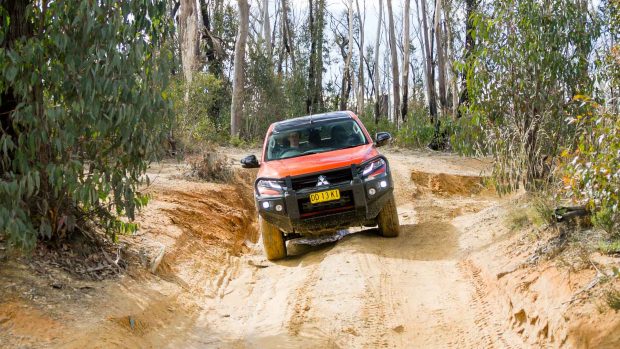
There was certainly some feedback from Triton owners and fans below our video, mostly centred around the Triton’s off-road prowess. In the megatest, we did include a technical off-road challenge, but we were examining these utes not with their traditional buyer type in mind, but rather up-spec dual cab models increasingly chosen by family buyers.
Therefore, the testing was weighted heavily towards technology, ease of interaction, cabin comfort and – crucially in the Mitsubishi’s case – on-road ride comfort. The Triton also lacks safety gear, with no rear cross-traffic alert, adaptive cruise control or lane-keep assist on any variant including the $55,690 (before on-road costs) GSR variant tested here in sunflare orange paint.
The GSR is the flagship Triton grade, making it a seemingly inexpensive rival for the Toyota Hilux Rogue ($70,200), Nissan Navara PRO-4X ($61,230) and Ford Ranger Wildtrak biturbo ($67,190). Mitsubishi doesn’t have a full-fat Ford Ranger Raptor or Navara Warrior rival yet, but executives hinted there could be one in the future.
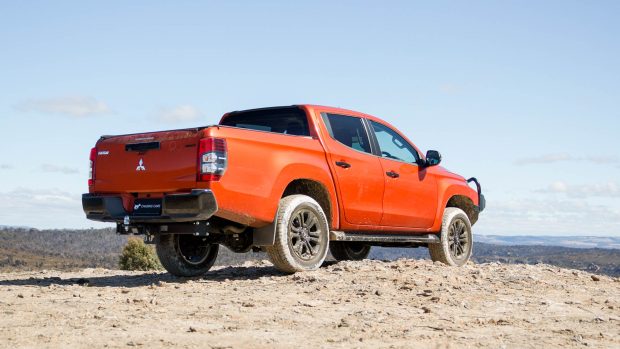
Even though the Triton’s bucking ride really does suck the joy out of city driving, we’ve given this dual cab a chance to redeem itself after its last place showing. We thought it prudent to spend a longer time with the ute, and get under its skin in a way you can’t in a time-crunched comparison test. That meant the Triton GSR spent its time skipping around Sydney’s inner suburbs, carting loads around and exploring off-road trails.
In 2015, the MQ Triton debuted with a new 133kW/430Nm alloy block 2.4-litre turbo-diesel four-cylinder. Against rivals, the engine’s outputs – on paper – are low. The Toyota Hilux once made a similar 130kW/450Nm, but that ute’s 2.8-litre diesel now develops a more generous 500Nm of torque, while Ford’s Ranger is available with a 184kW/600Nm V6.
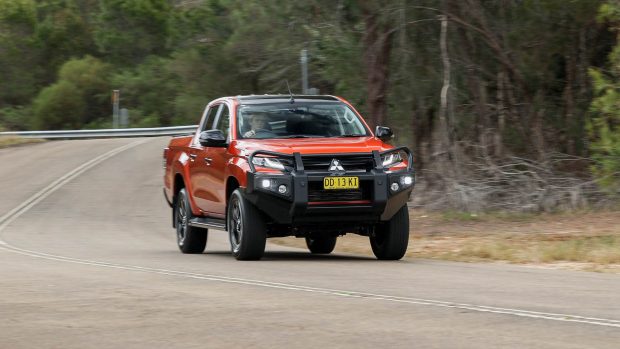
And yet the Triton’s powertrain is quite adequate for its relatively low weight (1999kg for the automatic GSR on test) and low-geared six-speed transmission. From 0-80km/h the Triton feels quite peppy – only at higher speeds does the ute struggle to pile on more pace. We recorded 0-100km/h and 80-120km/h times of 11.32 and 8.94 seconds respectively.
The Triton’s lack of refinement would have been acceptable a few years ago, but the segment has moved on. Even the Isuzu D-Max’s agricultural ‘4JJ’ engine has better sound insulation. Climbing the long, steep hills of the Bells Line of Road west of Sydney, the Triton’s constant drone gets to you – if the 3.1-tonne braked towing capacity was maxed out, the din would be worse still.
Unladen suspension performance is poor as well. Around Sydney’s Inner West where concrete expansion joints and speed humps are enemy number one, the Triton’s low-speed ride is abrupt and harsh. Carrying more speed settles the Triton’s ride, and with some weight in the tub the compliance of the leaf sprung rear end improves. You see where the additional money goes in a Ranger, Amarok or Navara suspension, if not the at-times bumpy Hilux.
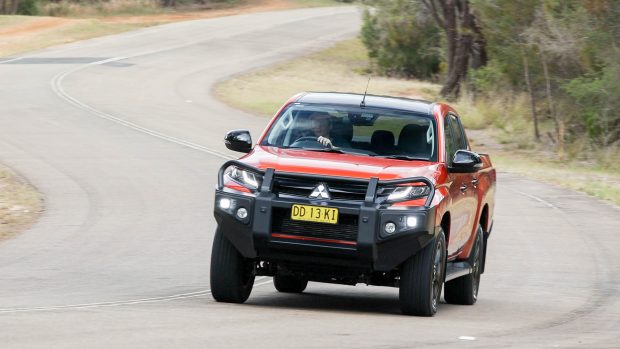
Though no amount of load can sort the juddering shock that gets telegraphed from the front tyres straight into the steering wheel. Big hits have the Triton’s wheel bouncing around in your hand. This deteriorates at high speed on country roads, where mid corner bumps seriously upset the Triton GSR’s balance.
Aside from a particularly well-calibrated ESC system and full-time 4WD from the Super Select system, the Triton’s safety aids leave a little to be desired for private buyers. There’s no digital speed readout, adaptive cruise control, lane-keep assist or reverse AEB on the GSR. However, the GSR and GLS are equipped with AEB with pedestrian detection, blind-spot monitoring and lane departure warning for a 2015 five-star ANCAP rating.
Without its off-road ability and scruffy charms the Triton would essentially be a lost cause. But there’s an admirable quality to this ute; a dual cab at its most pure that isn’t afraid to get stuck in.
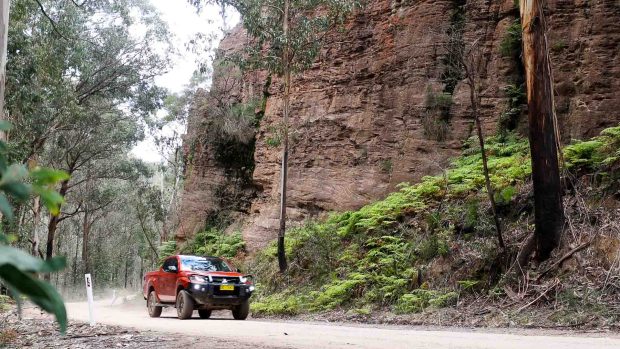
After bucking and lurching our way two hours west of Sydney, the Triton and I turned off onto some dirt access roads with the intention of heading to Lithgow’s ‘Lost City’ lookout. The ride actually settles down on high-speed dirt roads, and the straightforward Super Select AWD system gives confidence.
Turning into the first challenge, the recent bushfires have promoted lots of low-level Eucalyptus regrowth making the trails tighter than ever. This proved no problem for the 1815mm wide Triton as it’s 40mm narrower than a Toyota Hilux and 103mm slimmer than a new Ford Ranger.
Combined with its low weight (about 100kg less than equivalent Hilux), this makes the Triton nimble and wiedy off road. It’s also happy to winch itself up technical terrain.
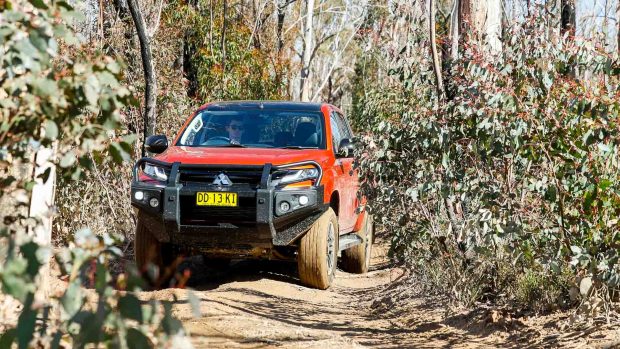
We found a section with offset moguls to test the Triton’s capability. The rear axle’s articulation is decent, but wasn’t enough to clear the section in low range without the rear differential lock engaged. That’s done with the press of a button, and the Triton then cruised its way up.
The rear differential is liable to get hung up on larger obstacles and the GSR’s 23º departure angle is a long way shy of Hilux (27º). If you’re serious about off-roading, then upgrading the Triton’s 265/60 18-inch Bridgestone Dueler Highway Terrain tyres to something more aggressive, teamed with a small lift and uprated suspension, would be big improvements.
With the Triton’s poor on-road refinement you might expect the same on dirt, but the low-range transfer case is one of the quietest in class and the suspension is relatively supple on dirt. Even the Triton’s orange peel paint finish helps to negate some of the deeper scratches you might pick up.
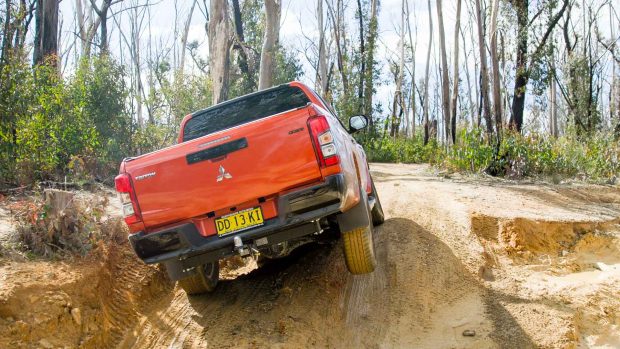
If you want a ute that is little more than just that, then the nimble Triton could be just the candidate. The Triton is rough and tumble but with some upgrades – that apparently Mitsubishi Australia is evaluating for a future variant – we reckon it could be a success story similar to the Nissan Navara Pro-4X Warrior.
The Triton feels like an authentic dual cab on the road, and the theme continues inside with scratchy plastics everywhere, a dated design and a lack of surprise and delight features.
There is at least a soft, squishy top for the centre armrest now. The Triton also features a 7.0-inch touchscreen with wired Apple CarPlay and Android Auto, and a lot of adjustment for the sound system. It isn’t great, but the six-speaker set up is better than dual cabs of old with reasonable power and clarity, considering the genre of vehicle.
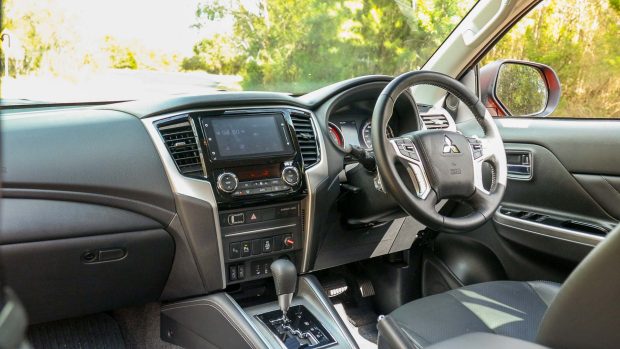
The Triton’s seats let the side down. There may be electric adjustment for the driver, leather upholstery and heating for both front seats, but on a three hour stint my back (that never normally gets sore) was in pain. Oddly, Chasing Cars cameraman Eddie Yabsley – who always gets a sore back in cars – found the passenger seat to be adequately comfortable.
In-cabin storage isn’t astounding and the Triton doesn’t have a split glove box like the Hilux, but there is storage under the armrest. The door bins have space for a 600mL bottle, and the two cupholders are sized well for a large coffee cup.
Due to its narrow body, the Triton’s back seat is only really good for two across the bench, but these two will be reasonably comfortable with good head and legroom for six-footers. The Triton has air vents in the roof and two USB-A charge ports as well.
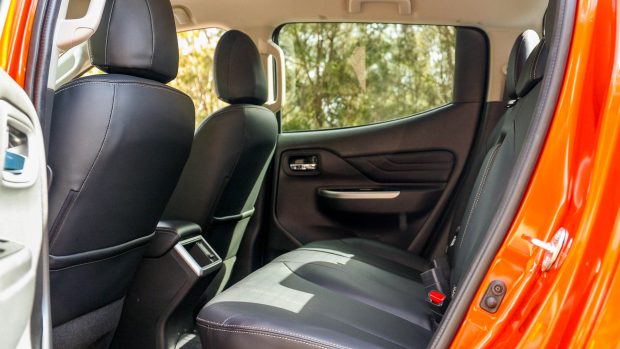
There’s a hint more hidden storage behind the Triton’s backrest and this is where you’ll find the jack and emergency tools. This is also where the top tether points are for child seats making for quite a difficult install of both front- and rear-facing seats in the Triton’s back seat.
With the introduction of the MN Triton in 2009 the Triton’s tub grew in length. The dual cab on test’s tray is now 1520mm long and 1470mm wide, though the 3000mm wheelbase hasn’t changed.
There were some issues with heavy payloads in early MN Tritons, though with additional chassis bracing this is said to no longer be an issue. The payload for this up-spec GSR automatic is 901kg, quite a lot less than rivals such as the Hilux SR5 (1045kg) and Navara Pro-4X (1004kg).
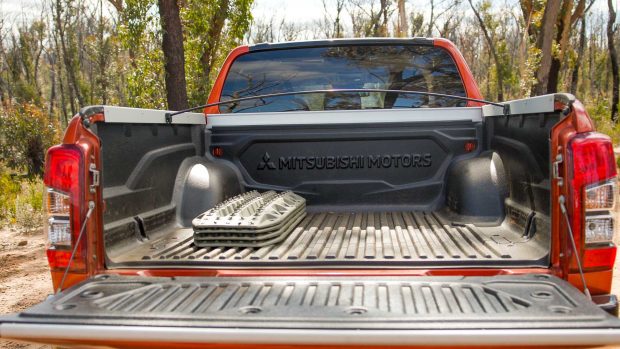
The Triton’s fuel consumption isn’t great. The combined ADR 81/02 figure is 8.1L/100km for the automatic, and our real-world testing saw the Triton get 10.5L/100km over 600km.
Servicing is due yearly or at 15,000km intervals for the Triton, whichever comes first. This means you can go further between visits to the dealer than the Toyota Hilux which needs to go back every six months/10,000km.
Mitsubishi has a name synonymous with reliability in Australia, and the Triton is no different. There are no major nail-in-coffin faults for this ute it seems. With some big names such as the Toyota Hilux famously facing reliability issues with its DPF, such a positive reliability image certainly aids the Triton in Australian sales charts.
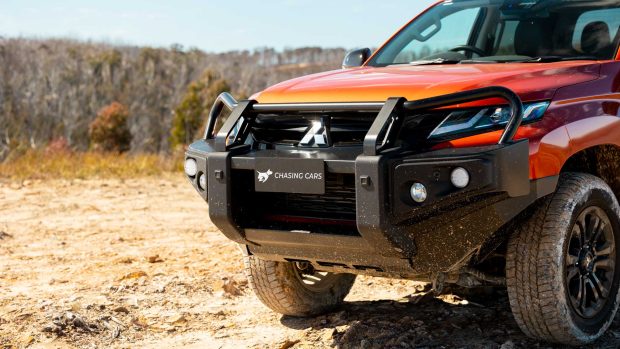
There are still things to look out for, of course. A cracking chassis from excessive or improper loading, the fact the Triton needs its valve clearances set every 30,000km and dampers that are known to wear out quickly. But there are fewer stories of Triton owners engine up stranded than a number of other vehicles.
And if anything does go wrong in your ownership – provided you service the vehicle on time – Mitsubishi’s 10-year/200,000km ‘Diamond Advantage’ warranty should put fears to rest.
Isuzu also covers its D-Max with a longer-than-normal six year warranty/150,000km, while the GWM Ute Cannon-X is covered by a seven-year, unlimited kilometre warranty. GWM’s warranty isn’t limited by kilometre count though, unlike Mitsubishi’s and Isuzu’s.
The Triton is a dual cab in the most traditional sense, the reliability and toughness is what sets this vehicle apart as its cabin finish and refinement are certainly not class leading. It feels dated and rudimentary inside, but you could argue the Triton offers far better value than a Toyota Hilux.
It doesn’t win out on objective measures, but the Triton’s plucky, do-anything, go-anywhere attitude is quite charming, too.
A vehicle can’t be assessed on charm alone, though, and the Triton’s on-road manners are sorely lacking. That engine may be relatively modern in technology terms, but the insulation isn’t. This is a loud and commercial feeling vehicle. The same is true of this ute’s stiff ride.
If you’re looking for a workhorse ute, then the value-packed Triton may be the pick of the bunch, but as this type of vehicles – especially in upper trims – climbs higher on family buyer’s lists, it’s hard to recommend the Triton over Isuzu, Mazda and Ford’s latest efforts.
Variant tested GSR (4x4)
Key specs (as tested)
About Chasing cars
Chasing Cars reviews are 100% independent.
Because we are powered by Budget Direct Insurance, we don’t receive advertising or sales revenue from car manufacturers.
We’re truly independent – giving you Australia’s best car reviews.
The estimate provided does not take into account your personal circumstances but is intended to give a general indication of the cost of insurance, in order to obtain a complete quote, please visit www.budgetdirect.com.au. Estimate includes 15%^ online discount.
^Conditions Apply
Budget Direct Insurance arranged by Auto & General Services Pty Ltd ACN 003 617 909(AGS) AFSL 241 411, for and on behalf of the insurer, Auto & General Insurance Company Limited(ABN 42 111 586 353, AFSL 285 571).Because we don’t know your financial needs, we can’t advise you if this insurance will suit you. You should consider your needs and the Product Disclosure Statement before making a decision to buy insurance. Terms and conditions apply.
Indicative quote based on assumptions including postcode , 40 year old male with no offences, licence suspensions or claims in the last 5 years, a NCD Rating 1 and no younger drivers listed. White car, driven up to 10,000kms a year, unfinanced, with no modifications, factory options and/or non-standard accessories, private use only and garaged at night.
^Online Discounts Terms & Conditions
1. Discounts apply to the premium paid for a new Budget Direct Gold Comprehensive Car Insurance, Third Party Property Only or Third Party Property, Fire & Theft Insurance policy initiated online on or after 29 March 2017. Discounts do not apply to optional Roadside Assistance.
2. Discounts do not apply to any renewal offer of insurance.
3. Discounts only apply to the insurance portion of the premium. Discounts are applied before government charges, taxes, levies and fees, including instalment processing fees (as applicable). The full extent of discounts may therefore be impacted.
4. We reserve the right to change the offer without notice.